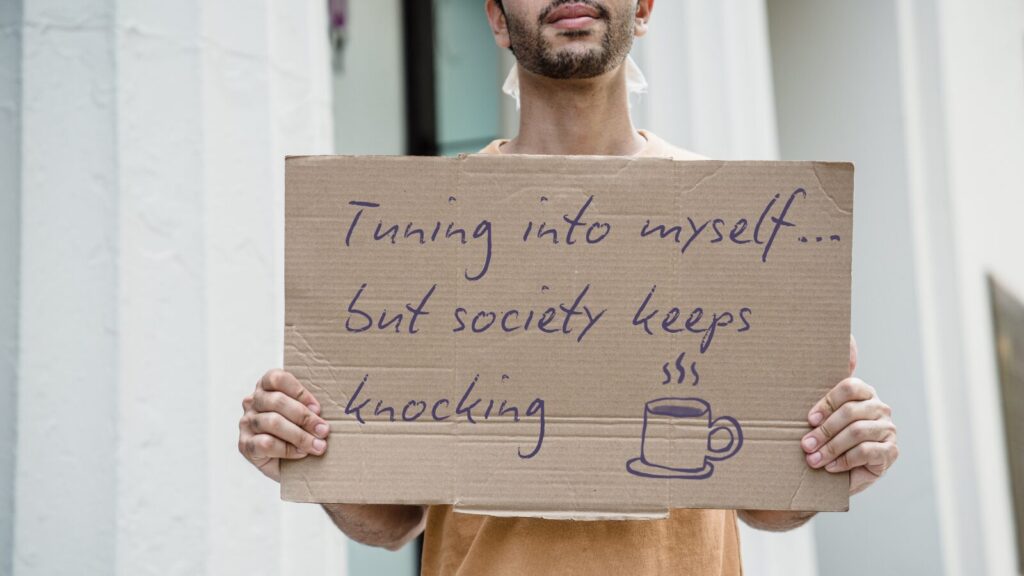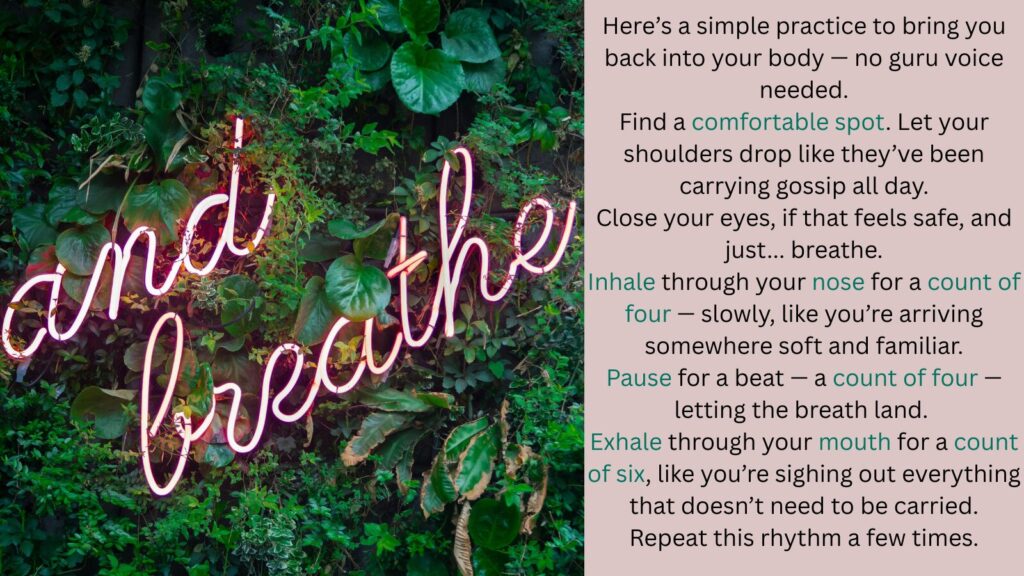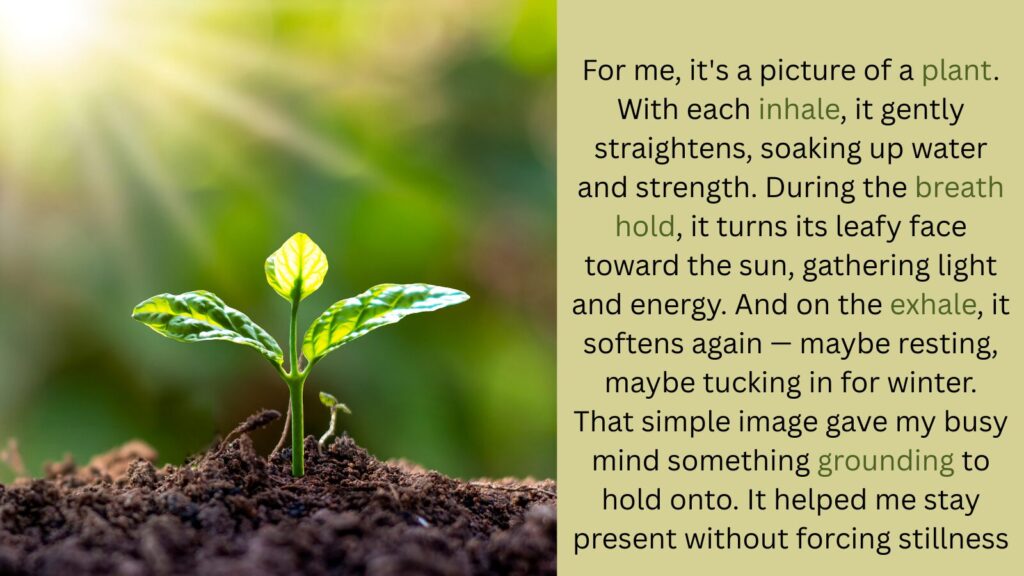As a part of my graduate project in sexology, I asked viewers on my YouTube channel for any ideas. One beautiful comment I got was how to make a lover more comfortable and natural in your presence, and how to have sex that feels intuitive, connected, and deeply meaningful rather than focused on performance or energy. I thought about it for a while, and everything I came up with seemed to circle back to one thing: presence. So I started to wonder — could that be the core of intimacy? I decided to call it that… at least until I get wiser or someone proves me wrong.
So. Presence. It sounds simple, smells profound, and often hides when you need it most. Let’s chase it a little bit and wonder what presence is, really, when it comes to intimacy? As I see it, presence means tuning into what’s happening in your body and emotions, bodily sensations, and surroundings, letting go of distractions, judgments, and expectations. It is observing things without being carried away by the past or present. Presence is about showing up for yourself and for the people you’re with. It’s about attuning to what you feel, honoring what your partner feels, and creating space for curiosity and not pressure. Let’s explore that thoroughly.
Being Present for Yourself
Being present with yourself is the foundation of intimacy, because you can’t truly meet someone else if you’re not even home. When you’re disconnected from your feelings, needs, or body, it’s easy to slip into performing — doing what you think you should do rather than what’s true for you. But intimacy doesn’t want a performance. It asks for something more raw, more real: for you to show up as you are, not as a role.
The more attuned you are to your own experience, the more you can share it honestly, set boundaries without guilt, and respond openly — not from survival mode, not from old patterns, but from right here and now.
Being present for yourself means tuning into your true feelings and sensations right now. Sometimes it’s the hardest thing to do. Especially when your mind wants to replay that awkward thing you said back in 2000. Individual obstacles can pull us away from this presence: past traumas, a challenging relationship with our bodies, not fully accepting ourselves as we are today, or mental health struggles. Society’s ideas about how sex or relationships should look, or how we should act as partners — shaped by gender roles or cultural expectations — can also get in the way.

Mindfulness, research tells us, can anchor us — in breath, in body, in now. Even simple practices like gentle breathing or quietly noticing sensation without judgment (Carson et al., 2004) can shift the whole experience. It quiets the anxious mind and invites us back into intuitive connection, where sex becomes less of a show and more of a shared moment. Emotional regulation isn’t about never feeling upset or overwhelmed. It’s about befriending your feelings enough to say, “Not now. I’ll listen later.”
“Mindfulness meditation doesn’t change life. Life remains as fragile and unpredictable as ever. Meditation changes the heart’s capacity to accept life as it is.” – Sylvia Boorstein.
Summarise:
- Noticing what’s getting in the way of your presence, such as past trauma, body image struggles, or mental health issues.
- Letting go of unrealistic expectations about how sex or relationships “must” look.
- Using mindfulness tools, like breathing exercises or non-judgmental awareness, to stay grounded in the here and now.
- Regulating your emotions so you can fully experience your desires and boundaries.
Tools: Easy Steps to Meet Yourself
Sometimes the stuff that trips us up from being present isn’t just a passing cloud—it’s more like a stubborn thunderstorm that might need a professional meteorologist (aka therapist) to help clear. That said, there are also some useful little daily practices—like mindfulness and gentle emotion regulation exercises—that can help us stay grounded, present, and connected with our inner world. Here is a small mindfulness breathing exercise and emotional regulation tip. Think of these as your everyday small but mighty spells, ready to help you dance a little lighter through life’s twists and turns.

If “just noticing your breath” feels about as exciting as watching a loading screen, you’re not alone. Stillness doesn’t always come easily, especially when your mind would rather rehearse your upcoming working day. Many of us need a little something to anchor us.

If it speaks to you, feel free to borrow it. Or — even better — let your imagination offer its own version: maybe you’re a wave rising and falling, a bird floating on wind, a tree swaying, a cat stretching.. Whatever helps your mind stay curious rather than wandering off into next week’s to-do list, go with that. There’s no wrong metaphor, as long as it brings you back to yourself. Mindfulness isn’t about emptying your head. It’s about arriving — just as you are.

Being Present for Your Partner
While presence with yourself is about tuning inward, presence with your partner is about turning that awareness outward. Intimacy lives in that exchange: the space where two people are actually with each other, not just next to each other. But we must be careful here, because just like wax figures at Madame Tussauds, two people can look impressively close — until you realize no one’s blinking. Disconnection sneaks in quietly — through stress, resentment, boredom, or just the slow erosion of attention over time. But intimacy can’t survive on autopilot. You can’t connect to someone if you’re relating to the version of them from six months ago, or to the version your mother warned you about. Presence is what makes space for who they are now — which is the only person you can actually touch, hear, and love.

Being present for your partner means creating a space free of judgment and control. Connection, safety, and trust aren’t just built in the bedroom — they grow through daily acts. This might mean listening actively when they share their day, offering support without immediately trying to fix things, or showing affection in small, casual ways — like making their favorite tea when they want some.
These everyday moments build the foundation for more intimate sexual experiences. As a result, you will both feel safer and more open for here and now versus worries of the past and future. Being present for your partner doesn’t mean staring into their soul 24/7. Sometimes it simply means handing them a snack when the world feels too loud.
Why Touch Matters
We usually think of touch as just something casual, like when you accidentally bump elbows in a crowded elevator. But touch is much more than a fleeting moment; it’s a quiet way of saying, “I’m here,” without uttering a single word. Think of it as emotional Bluetooth—connecting us, just without all the awkward buffering. And science agrees: touch is one of the best ways to build safety, intimacy, and lasting bonds. Let’s peek behind the curtain and see the science that turns a simple touch into a secret superpower.
💛 Touch regulates our nervous system.
According to Feldman et al. (2010), affectionate physical contact — such as stroking, cuddling, or gentle holding — helps regulate cortisol. In simpler terms, it calms our stress. The body literally starts to feel safer when being touched with care. Physical touch releases oxytocin, the “bonding hormone,” which promotes feelings of trust and closeness (Light et al., 2005). So touch also deepens our sense of connection.
💛 Touch strengthens relationships daily.
A study by Van Lankveld et al. (2021) found that moments of physical affection — like holding hands, hugging, or resting together — were strongly associated with both intimacy and sexual satisfaction in couples. What stood out was this: these effects didn’t just show up during sex. Touch in daily life had the biggest impact.
💛 It’s not about performance — it’s about presence.
When partners experience touch that’s attuned — meaning it’s given with awareness, respect, and a sense of timing — it activates what psychologist Marieke Dewitte calls “a synchrony loop.” This is a process where two nervous systems start to align. Think: slowing heartbeats, relaxed breathing, feeling “on the same page” emotionally.
Summarise
- Avoiding judgment and control.
- Actively listening when your partner shares without rushing to fix.
- Offering small, caring gestures like making their favorite tea or checking in on how they feel.
- Asking instead of assuming their needs or feelings.
- Casual touch practice daily
Tools For Staying Present Together
Being present with your partner might sound simple, but it’s a skill worth practicing, like learning to ride a bike, only with fewer scraped knees and more warm hugs. These exercises are here to help you tune in, communicate without words, and build connection one small moment at a time. No pressure, no perfect moves—just two people showing up, curious and ready to explore the presence together.
Active Listening Exercise: “Echoes of Us”
How to play:
Imagine you’re a kind, friendly parrot — but instead of squawking the same words, you reflect the feel of what your partner says. When they share something, your job is to catch the vibe and toss it right back like a cozy conversational boomerang.
For example:
Speaker: “I had a tough day at work.”
Listener: “It sounds like your day weighed heavily on your shoulders.”
No need to fix, advise, or solve — just be the best echo in the room. It’s like saying, “I’m listening so hard, I almost want to record you!”
Pro tip: If you accidentally turn into a robot or start thinking about dinner, just smile, rewind, and try again. Connection is a dance, not a test!
✨ Simple Touch Practices to Include
- Daily hand-holding, hugs, or cuddles—in non-sexual moments.
- Mindful touch exercises like the one above
- Nighttime cuddles before sleep to calm the nervous system.
- Short romantic rituals: a 6-second kiss or forehead-to-forehead moment.
These are just tender invitations. I’m sure your own love languages are even more poetic. And if they are — tell me. I’d love to hear them. Sharing, after all, is part of the magic.
Curiosity: The Relationship Defibrillator
One more important ingredient in fostering intimacy besides presence is curiosity. When you stay genuinely curious about your partner’s thoughts, desires, weird little habits, or even their strange anxieties, you turn what could be a stale routine into an ongoing discovery. A study in the Journal of Social and Personal Relationships found that partners who actually make the effort to understand each other’s inner weirdness tend to get along better and fight less — who knew? Meanwhile, research from the Journal of Personality shows that curiosity acts like an emotional defibrillator, encouraging openness and vulnerability, which are basically the secret spices for deep connection and, yes, better sex. Curiosity smashes down the walls you didn’t even know you built. It also fosters trust, enhances communication, and ignites passion, turning sex and connection into a dynamic, evolving experience rather than a repetitive checklist.
Small Moves, Big Intimacy
Intimacy doesn’t thrive on autopilot — it needs fresh air. These small, curiosity-sparking exercises are designed to slip into daily life without turning your relationship into a therapy session.
1. “Two Surprising Truths”
Each partner shares two things they think the other doesn’t know about them — small, fun, or strange.
Examples:
- “I once ate a whole jar of pickles in one sitting.”
- “When I was 11, I wanted to be a vampire hunter.”
Why it works: It invites curiosity in a playful, non-threatening way, because curiosity doesn’t always have to lead to tears or trauma bonding. Sometimes, it just helps to remember your partner is a whole weirdo you haven’t fully discovered yet — and you probably are too.
2. “Ask Me Something New”
A lightweight agreement: once a day, each partner asks the other one a question they’ve never asked before.
Even if it’s silly: “Would you rather fight 100 duck-sized horses or one horse-sized duck?”
Why it works: Because even if you’ve been together forever, there’s always more to find — unless you’re dating a very sophisticated AI. And let’s be honest, sometimes the weird questions lead to the best conversations (or at least to laughing in bed, which is kind of the same thing).
3. “Swap the Script”
Once a week, swap roles in something small and familiar — the person who usually cooks chooses a show to watch, or the introvert plans the social event (within reason!).
Afterward, talk briefly about the experience.
Why it works: It keeps the mental space between partners fresh and surprising, because nothing kills curiosity like routine. This keeps you from turning into domestic coworkers with shared chores and separate lives. Plus, mild discomfort with a supportive partner on your side builds character and enhances intimacy.
The Sexual Side of Attachment: Why We Connect (or Don’t)
One dynamic that quietly shapes how we connect — both emotionally and sexually — is attachment style. It doesn’t just flare up during conflict or cling to how we give affection. It follows us to bed, influencing how safe, close, or distant we feel. But what exactly is attachment style? You know those moments when someone says, ‘I need space,’ and your whole nervous system throws a tantrum? Or when someone says ‘I miss you’ and suddenly you want to relocate to a cabin in the woods and change your number? That’s your attachment style waving hello. Attachment theory is like a personality test nobody asked for, slightly intrusive, eerily accurate, and suddenly explaining half your love life. Among other things, attachment theory can help us understand why some people struggle to be fully present during sex.

A recent study looking at how attachment styles shape our sex lives found that insecure patterns — like craving constant reassurance or keeping emotional distance — tend to get in the way of deeply satisfying experiences for both partners (Beaulieu et al., 2023). After all, if we’re busy seeking approval or tiptoeing around vulnerability, it’s no wonder intimacy gets a little tangled. Let’s delve into the attachment style nuances and study the key findings.
For an anxiously attached person, the core idea behind attachment is the fear of abandonment. Hence, the anxiety that comes with an intimate connection. At this point, sex becomes a way to regulate fear of abandonment, rather than a space to connect or explore, just like holding someone’s hand so they don’t walk away, not because you want to feel their touch. The mentioned study showed how anxious attachment deals with intimacy and sex:
-Often have sex to seek reassurance or reduce anxiety (“Will you still love me?”)
-These motives often led to less satisfaction and more negative emotions during and after sex
-Their partners often felt the emotional weight of that anxiety, too
For someone with an avoidant attachment style, the fear runs in the opposite direction — it’s not about being left, but about being engulfed. Intimacy threatens their sense of autonomy and the emotional balance they’ve worked hard to maintain. Vulnerability feels risky, raw emotions overwhelming. So sex becomes safer when it stays physical, not emotional, because it feels secure that way. This often leaves their partners reaching for connection and finding distance instead. The mentioned study showed how avoidant attachment deals with intimacy and sex:
-They tend to distance themselves emotionally during sex
-They engage in sex, but often with less emotional involvement or as a way to avoid closeness
-Partners may feel a lack of emotional connection during intimacy
To sum it up, when insecure attachment is in the driver’s seat, sex tends to be more about managing subconscious fears than truly connecting or showing up with your partner.
“Attachment insecurity is associated with using sex to fulfill non-sexual needs, such as reducing anxiety or boosting self-esteem.”
— Shaver & Mikulincer, 2007
For a securely attached person, sharing emotional waves with a partner doesn’t threaten their sense of freedom. They also have a sturdy emotional toolkit for riding their own storms, so attachment doesn’t come with dependency. As John Bowlby, the father of attachment theory, said:
“Life is best organized as a series of daring ventures from a secure base.”
Sex, too, can be one of those ventures — safe, connected, and alive.
Let’s see an overview of what the mentioned study showed about how secure attachment deals with intimacy and sex:
-Engaging in sex for mutual connection, pleasure, and closeness
-Reported higher emotional satisfaction and better sexual well-being overall
-Their partners also felt more satisfied and emotionally fulfilled
“When people feel securely attached, they are more likely to approach sex as an opportunity to connect with their partner, rather than to cope with anxiety or gain reassurance.”
— Mikulincer & Shaver, Attachment in Adulthood (2016)
If you bring to bed the skill of being present with yourself, the art of being present with your partner, a spark of curiosity, the power of touch, and a little awareness of your attachment-style reflexes — something shifts. Your partner is more likely to feel comfortable, safe, and seen. You start co-creating an experience where connection matters more than performance. And so here we are — a little wiser, a little more curious, and perhaps a little more comfortable with the art of mindful sex (and slightly less weirded out by breathing exercises). Whether you’re practicing presence solo or learning the secret power of touch with a partner, it’s never about being perfect or knowing all the answers. You might still zone out mid-hug, overthink a pause, or forget what your partner just said because your brain took a coffee break. That’s okay. Presence is a practice, not a personality trait.
And if your attachment style sometimes crashes the party with old fears or habits, at least now you know who’s been rearranging the furniture in your emotional living room. What is important is that you’re allowed to grow new ways of connecting, with small steps and deep breaths.
Try things. Be curious. Talk. Touch. Mess up. Laugh. Come back to yourself, and to each other. That’s intimacy. No magic spells required—just humans, trying.




